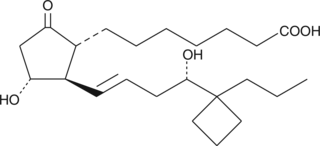Cayman
Showing 12751–12900 of 45550 results
-
Budesonide is a glucocorticoid and an agonist of glucocorticoid receptors (EC50 = 45.7 pM in a transactivation assay).{41565} It is selective for glucocorticoid over mineralocorticoid receptors (EC50 = 7,620 pM). Budesonide inhibits LPS-induced TNF-α release from human peripheral blood mononuclear cells (PBMCs; IC50 = 0.96 nM).{25238} It reduces levels of IL-1β and eotaxin in the lungs and the number of eosinophils and neutrophils in bronchoalveolar lavage fluid (BALF) in a rat model of ovalbumin-induced airway inflammation when administered at a dose of 3 mg/kg.{24240} Intracolonic administration of budesonide decreases colon wet weight and colonic myeloperoxidase (MPO) activity in a rat model of oxazolone-induced colitis.{52378} Formulations containing budesonide have been used in the treatment of Crohn’s disease, ulcerative colitis, allergic rhinitis, and asthma.
Brand:CaymanSKU:-Budesonide is a glucocorticoid and an agonist of glucocorticoid receptors (EC50 = 45.7 pM in a transactivation assay).{41565} It is selective for glucocorticoid over mineralocorticoid receptors (EC50 = 7,620 pM). Budesonide inhibits LPS-induced TNF-α release from human peripheral blood mononuclear cells (PBMCs; IC50 = 0.96 nM).{25238} It reduces levels of IL-1β and eotaxin in the lungs and the number of eosinophils and neutrophils in bronchoalveolar lavage fluid (BALF) in a rat model of ovalbumin-induced airway inflammation when administered at a dose of 3 mg/kg.{24240} Intracolonic administration of budesonide decreases colon wet weight and colonic myeloperoxidase (MPO) activity in a rat model of oxazolone-induced colitis.{52378} Formulations containing budesonide have been used in the treatment of Crohn’s disease, ulcerative colitis, allergic rhinitis, and asthma.
Brand:CaymanSKU:-Budesonide is a glucocorticoid and an agonist of glucocorticoid receptors (EC50 = 45.7 pM in a transactivation assay).{41565} It is selective for glucocorticoid over mineralocorticoid receptors (EC50 = 7,620 pM). Budesonide inhibits LPS-induced TNF-α release from human peripheral blood mononuclear cells (PBMCs; IC50 = 0.96 nM).{25238} It reduces levels of IL-1β and eotaxin in the lungs and the number of eosinophils and neutrophils in bronchoalveolar lavage fluid (BALF) in a rat model of ovalbumin-induced airway inflammation when administered at a dose of 3 mg/kg.{24240} Intracolonic administration of budesonide decreases colon wet weight and colonic myeloperoxidase (MPO) activity in a rat model of oxazolone-induced colitis.{52378} Formulations containing budesonide have been used in the treatment of Crohn’s disease, ulcerative colitis, allergic rhinitis, and asthma.
Brand:CaymanSKU:-Budesonide is a glucocorticoid and an agonist of glucocorticoid receptors (EC50 = 45.7 pM in a transactivation assay).{41565} It is selective for glucocorticoid over mineralocorticoid receptors (EC50 = 7,620 pM). Budesonide inhibits LPS-induced TNF-α release from human peripheral blood mononuclear cells (PBMCs; IC50 = 0.96 nM).{25238} It reduces levels of IL-1β and eotaxin in the lungs and the number of eosinophils and neutrophils in bronchoalveolar lavage fluid (BALF) in a rat model of ovalbumin-induced airway inflammation when administered at a dose of 3 mg/kg.{24240} Intracolonic administration of budesonide decreases colon wet weight and colonic myeloperoxidase (MPO) activity in a rat model of oxazolone-induced colitis.{52378} Formulations containing budesonide have been used in the treatment of Crohn’s disease, ulcerative colitis, allergic rhinitis, and asthma.
Brand:CaymanSKU:-Budesonide-d8 is intended for use as an internal standard for the quantification of budesonide (Item No. 15407) by GC- or LC-MS. Budesonide is a glucocorticoid and an agonist of glucocorticoid receptors (EC50 = 45.7 pM in a transactivation assay).{41565} It is selective for glucocorticoid over mineralocorticoid receptors (EC50 = 7,620 pM). Budesonide inhibits LPS-induced TNF-α release from human peripheral blood mononuclear cells (PBMCs; IC50 = 0.96 nM).{25238} It reduces levels of IL-1β and eotaxin in the lungs and the number of eosinophils and neutrophils in bronchoalveolar lavage fluid (BALF) in a rat model of ovalbumin-induced airway inflammation when administered at a dose of 3 mg/kg.{24240} Intracolonic administration of budesonide decreases colon wet weight and colonic myeloperoxidase (MPO) activity in a rat model of oxazolone-induced colitis.{52378} Formulations containing budesonide have been used in the treatment of Crohn’s disease, ulcerative colitis, allergic rhinitis, and asthma.
Brand:CaymanSKU:30046 - 1 mgAvailable on backorder
Bufalin is a cardiotonic steroid first isolated from toad venom and used in traditional Asian medicine.{29917,29914} It inhibits the Na+/K+-ATPase transporter (Kds = 42, 45, and 40 nM for the α1, α2, and α3 subunits, respectively).{29469} Intravenously administered bufalin is cleared rapidly, with a plasma half-life of 25 minutes in dogs and rats.{29913} Bufalin inhibits steroid receptor coactivator 1 (SRC-1) and SRC-3 at doses as low as 5 nM, promotes the degradation of SRC-3 protein, and inhibits cancer cell growth both in vitro and in vivo.{25457} It can also impact the action and expression of several other proteins and kinases as well as induce apoptosis in various cancer cells.{29915,29916}
Brand:CaymanSKU:-Bufalin is a cardiotonic steroid first isolated from toad venom and used in traditional Asian medicine.{29917,29914} It inhibits the Na+/K+-ATPase transporter (Kds = 42, 45, and 40 nM for the α1, α2, and α3 subunits, respectively).{29469} Intravenously administered bufalin is cleared rapidly, with a plasma half-life of 25 minutes in dogs and rats.{29913} Bufalin inhibits steroid receptor coactivator 1 (SRC-1) and SRC-3 at doses as low as 5 nM, promotes the degradation of SRC-3 protein, and inhibits cancer cell growth both in vitro and in vivo.{25457} It can also impact the action and expression of several other proteins and kinases as well as induce apoptosis in various cancer cells.{29915,29916}
Brand:CaymanSKU:-Bufalin is a cardiotonic steroid first isolated from toad venom and used in traditional Asian medicine.{29917,29914} It inhibits the Na+/K+-ATPase transporter (Kds = 42, 45, and 40 nM for the α1, α2, and α3 subunits, respectively).{29469} Intravenously administered bufalin is cleared rapidly, with a plasma half-life of 25 minutes in dogs and rats.{29913} Bufalin inhibits steroid receptor coactivator 1 (SRC-1) and SRC-3 at doses as low as 5 nM, promotes the degradation of SRC-3 protein, and inhibits cancer cell growth both in vitro and in vivo.{25457} It can also impact the action and expression of several other proteins and kinases as well as induce apoptosis in various cancer cells.{29915,29916}
Brand:CaymanSKU:-Bufalin is a cardiotonic steroid first isolated from toad venom and used in traditional Asian medicine.{29917,29914} It inhibits the Na+/K+-ATPase transporter (Kds = 42, 45, and 40 nM for the α1, α2, and α3 subunits, respectively).{29469} Intravenously administered bufalin is cleared rapidly, with a plasma half-life of 25 minutes in dogs and rats.{29913} Bufalin inhibits steroid receptor coactivator 1 (SRC-1) and SRC-3 at doses as low as 5 nM, promotes the degradation of SRC-3 protein, and inhibits cancer cell growth both in vitro and in vivo.{25457} It can also impact the action and expression of several other proteins and kinases as well as induce apoptosis in various cancer cells.{29915,29916}
Brand:CaymanSKU:-Bufexamac is an NSAID and inhibitor of the class IIb histone deacetylases HDAC6 and HDAC10.{43497} It inhibits the production of IFN-α in peripheral blood mononuclear cells (PBMCs; EC50 = 8.9 µM). Bufexamac induces hyperacetylation of tubulin (IC50 = 2.9 µM), a major substrate of HDAC6, without increasing acetylation of the class I HDAC substrates H3K5 or H3K9/K14. It also inhibits leukotriene A4 (LTA4) hydrolase and aminopeptidase activity (IC50s = 15.86 and 11.59 µM, respectively) and 5-lipoxygenase (5-LO) activity (IC50 = 27 µM).{43498,43499} Bufexamac inhibits the production of leukotriene B4 (LTB4; Item No. 20110) in neutrophils (IC50 = 12.91 µM) and reduces fMLP-induced neutrophil migration when used at concentrations of 50 and 100 µM.{43498} It also reduces neutrophil levels, as well as protein levels of TNF-α and IL-1β, in bronchoalveolar lavage fluid (BALF) in a mouse model of LPS-induced acute lung injury when administered at a dose of 100 mg/kg.
Brand:CaymanSKU:26068 - 100 mgAvailable on backorder
Bufexamac is an NSAID and inhibitor of the class IIb histone deacetylases HDAC6 and HDAC10.{43497} It inhibits the production of IFN-α in peripheral blood mononuclear cells (PBMCs; EC50 = 8.9 µM). Bufexamac induces hyperacetylation of tubulin (IC50 = 2.9 µM), a major substrate of HDAC6, without increasing acetylation of the class I HDAC substrates H3K5 or H3K9/K14. It also inhibits leukotriene A4 (LTA4) hydrolase and aminopeptidase activity (IC50s = 15.86 and 11.59 µM, respectively) and 5-lipoxygenase (5-LO) activity (IC50 = 27 µM).{43498,43499} Bufexamac inhibits the production of leukotriene B4 (LTB4; Item No. 20110) in neutrophils (IC50 = 12.91 µM) and reduces fMLP-induced neutrophil migration when used at concentrations of 50 and 100 µM.{43498} It also reduces neutrophil levels, as well as protein levels of TNF-α and IL-1β, in bronchoalveolar lavage fluid (BALF) in a mouse model of LPS-induced acute lung injury when administered at a dose of 100 mg/kg.
Brand:CaymanSKU:26068 - 25 mgAvailable on backorder
Bufexamac is an NSAID and inhibitor of the class IIb histone deacetylases HDAC6 and HDAC10.{43497} It inhibits the production of IFN-α in peripheral blood mononuclear cells (PBMCs; EC50 = 8.9 µM). Bufexamac induces hyperacetylation of tubulin (IC50 = 2.9 µM), a major substrate of HDAC6, without increasing acetylation of the class I HDAC substrates H3K5 or H3K9/K14. It also inhibits leukotriene A4 (LTA4) hydrolase and aminopeptidase activity (IC50s = 15.86 and 11.59 µM, respectively) and 5-lipoxygenase (5-LO) activity (IC50 = 27 µM).{43498,43499} Bufexamac inhibits the production of leukotriene B4 (LTB4; Item No. 20110) in neutrophils (IC50 = 12.91 µM) and reduces fMLP-induced neutrophil migration when used at concentrations of 50 and 100 µM.{43498} It also reduces neutrophil levels, as well as protein levels of TNF-α and IL-1β, in bronchoalveolar lavage fluid (BALF) in a mouse model of LPS-induced acute lung injury when administered at a dose of 100 mg/kg.
Brand:CaymanSKU:26068 - 250 mgAvailable on backorder
Bufexamac is an NSAID and inhibitor of the class IIb histone deacetylases HDAC6 and HDAC10.{43497} It inhibits the production of IFN-α in peripheral blood mononuclear cells (PBMCs; EC50 = 8.9 µM). Bufexamac induces hyperacetylation of tubulin (IC50 = 2.9 µM), a major substrate of HDAC6, without increasing acetylation of the class I HDAC substrates H3K5 or H3K9/K14. It also inhibits leukotriene A4 (LTA4) hydrolase and aminopeptidase activity (IC50s = 15.86 and 11.59 µM, respectively) and 5-lipoxygenase (5-LO) activity (IC50 = 27 µM).{43498,43499} Bufexamac inhibits the production of leukotriene B4 (LTB4; Item No. 20110) in neutrophils (IC50 = 12.91 µM) and reduces fMLP-induced neutrophil migration when used at concentrations of 50 and 100 µM.{43498} It also reduces neutrophil levels, as well as protein levels of TNF-α and IL-1β, in bronchoalveolar lavage fluid (BALF) in a mouse model of LPS-induced acute lung injury when administered at a dose of 100 mg/kg.
Brand:CaymanSKU:26068 - 50 mgAvailable on backorder
Buflomedil is a non-selective antagonist of α-adrenergic receptors (α-ARs) and vasoactive compound.{58021,58022,58023,58024} It binds to rat α1A- and α1B-ARs (Kis = 4.06 and 6.84 µM, respectively) and human platelet α2-ARs (IC50 = 1 µM) in radioligand binding assays.{58021,58022} Buflomedil (0.06-60 µM) inhibits contraction of isolated canine saphenous veins induced by phenylephrine, clonidine (Item No. 15949), sympathetic nerve stimulation, or norepinephrine.{58023} It inhibits ADP-, collagen-, or epinephrine-induced aggregation of isolated human platelets when used at a concentration of 100 µM.{58022} Buflomedil (10 mg/kg) reduces hippocampal neuronal cell death in a rat model of carotid clamping-induced ischemia-reperfusion injury.{58024}
Brand:CaymanSKU:31184 - 10 gAvailable on backorder
Buflomedil is a non-selective antagonist of α-adrenergic receptors (α-ARs) and vasoactive compound.{58021,58022,58023,58024} It binds to rat α1A- and α1B-ARs (Kis = 4.06 and 6.84 µM, respectively) and human platelet α2-ARs (IC50 = 1 µM) in radioligand binding assays.{58021,58022} Buflomedil (0.06-60 µM) inhibits contraction of isolated canine saphenous veins induced by phenylephrine, clonidine (Item No. 15949), sympathetic nerve stimulation, or norepinephrine.{58023} It inhibits ADP-, collagen-, or epinephrine-induced aggregation of isolated human platelets when used at a concentration of 100 µM.{58022} Buflomedil (10 mg/kg) reduces hippocampal neuronal cell death in a rat model of carotid clamping-induced ischemia-reperfusion injury.{58024}
Brand:CaymanSKU:31184 - 5 gAvailable on backorder
Buformin is a biguanide derivative with antihyperglycemic activity. It delays absorption of glucose from the gastrointestinal tract, increases insulin sensitivity and glucose utilization in peripheral cells, and inhibits hepatic gluconeogenesis.{29950} It can also deactivate the glycolytic pathway by suppressing glyceraldehyde 3-phosphate dehydrogenase gene expression, which can lead to lactic acidosis.{29952} Biguanides, such as buformin, are reported to inhibit the mitochondrial respiratory complex I by inhibiting ubiquinone reduction and by stimulating reactive oxygen species production via the complex I flavin.{29949} Some biguanides, including buformin, can also inhibit the mitochondrial ATP synthase.{29949} Buformin has also been examined for antitumor activity due to its ability to disrupt the unfolded protein response transcription program during glucose deprivation, which induces cell death in glucose-deprived tumor cells.{29951}
Brand:CaymanSKU:-Available on backorder
Buformin is a biguanide derivative with antihyperglycemic activity. It delays absorption of glucose from the gastrointestinal tract, increases insulin sensitivity and glucose utilization in peripheral cells, and inhibits hepatic gluconeogenesis.{29950} It can also deactivate the glycolytic pathway by suppressing glyceraldehyde 3-phosphate dehydrogenase gene expression, which can lead to lactic acidosis.{29952} Biguanides, such as buformin, are reported to inhibit the mitochondrial respiratory complex I by inhibiting ubiquinone reduction and by stimulating reactive oxygen species production via the complex I flavin.{29949} Some biguanides, including buformin, can also inhibit the mitochondrial ATP synthase.{29949} Buformin has also been examined for antitumor activity due to its ability to disrupt the unfolded protein response transcription program during glucose deprivation, which induces cell death in glucose-deprived tumor cells.{29951}
Brand:CaymanSKU:-Available on backorder
Buformin is a biguanide derivative with antihyperglycemic activity. It delays absorption of glucose from the gastrointestinal tract, increases insulin sensitivity and glucose utilization in peripheral cells, and inhibits hepatic gluconeogenesis.{29950} It can also deactivate the glycolytic pathway by suppressing glyceraldehyde 3-phosphate dehydrogenase gene expression, which can lead to lactic acidosis.{29952} Biguanides, such as buformin, are reported to inhibit the mitochondrial respiratory complex I by inhibiting ubiquinone reduction and by stimulating reactive oxygen species production via the complex I flavin.{29949} Some biguanides, including buformin, can also inhibit the mitochondrial ATP synthase.{29949} Buformin has also been examined for antitumor activity due to its ability to disrupt the unfolded protein response transcription program during glucose deprivation, which induces cell death in glucose-deprived tumor cells.{29951}
Brand:CaymanSKU:-Available on backorder
Bufuralol is a non-specific β-adrenergic blocker with affinity for both β1 and β2-adrenergic receptors. It acts as a potent β-adrenoceptor antagonist with partial agonist activity.{29043} It is primarily metabolized by cytochrome P450 (CYP) isoform CYP2D6, with CYP1A2 and CYP2C19 also contributing to 1’-hydroxylation.{29042}
Brand:CaymanSKU:-Available on backorder
Bufuralol is a non-specific β-adrenergic blocker with affinity for both β1 and β2-adrenergic receptors. It acts as a potent β-adrenoceptor antagonist with partial agonist activity.{29043} It is primarily metabolized by cytochrome P450 (CYP) isoform CYP2D6, with CYP1A2 and CYP2C19 also contributing to 1’-hydroxylation.{29042}
Brand:CaymanSKU:-Available on backorder
Bufuralol is a non-specific β-adrenergic blocker with affinity for both β1 and β2-adrenergic receptors. It acts as a potent β-adrenoceptor antagonist with partial agonist activity.{29043} It is primarily metabolized by cytochrome P450 (CYP) isoform CYP2D6, with CYP1A2 and CYP2C19 also contributing to 1’-hydroxylation.{29042}
Brand:CaymanSKU:-Available on backorder
Bufuralol-d9 is intended for use as an internal standard for the quantification of bufuralol (Item No. 17794) by GC- or LC-MS. Bufuralol is a non-selective antagonist of β-adrenergic receptors (β-ARs) that also has partial agonist activity.{29042,29043,45566} It decreases mean arterial blood pressure and increases abdominal aortic blood flow in anesthetized cats when administered intravenously at doses of 0.3 and 1 mg/kg.{45566} Bufuralol is hydroxylated at the 1′ position by the cytochrome P450 (CYP) isoform CYP2D6 and has been used as a substrate to measure CYP2D6 activity.{37036,29042,11736,45565}
Brand:CaymanSKU:29081 - 1 mgAvailable on backorder
Bumetanide is a loop diuretic with good absorption and pharmacodynamic properties.{23240,23239} It acts as an inhibitor of the Na-K-Cl cotransporter 1 (NKCC1) and the kidney-specific NKCC2 (Ki = 0.5 and 59 μM for human and rabbit NKCC1, respectively).{23243,23244} Bumetanide also inhibits several isoforms of carbonic anhydrase.{23242}
Brand:CaymanSKU:-Bumetanide is a loop diuretic with good absorption and pharmacodynamic properties.{23240,23239} It acts as an inhibitor of the Na-K-Cl cotransporter 1 (NKCC1) and the kidney-specific NKCC2 (Ki = 0.5 and 59 μM for human and rabbit NKCC1, respectively).{23243,23244} Bumetanide also inhibits several isoforms of carbonic anhydrase.{23242}
Brand:CaymanSKU:-Bumetanide is a loop diuretic with good absorption and pharmacodynamic properties.{23240,23239} It acts as an inhibitor of the Na-K-Cl cotransporter 1 (NKCC1) and the kidney-specific NKCC2 (Ki = 0.5 and 59 μM for human and rabbit NKCC1, respectively).{23243,23244} Bumetanide also inhibits several isoforms of carbonic anhydrase.{23242}
Brand:CaymanSKU:-Bumetanide is a loop diuretic with good absorption and pharmacodynamic properties.{23240,23239} It acts as an inhibitor of the Na-K-Cl cotransporter 1 (NKCC1) and the kidney-specific NKCC2 (Ki = 0.5 and 59 μM for human and rabbit NKCC1, respectively).{23243,23244} Bumetanide also inhibits several isoforms of carbonic anhydrase.{23242}
Brand:CaymanSKU:-Bumetanide-d5 is intended for use as an internal standard for the quantification of bumetanide (Item No. 14630) by GC- or LC-MS. Bumetanide is a loop diuretic with good absorption and pharmacodynamic properties.{23240,23239} It acts as an inhibitor of the Na-K-Cl cotransporter 1 (NKCC1) and the kidney-specific NKCC2 (Kis = 0.5 and 59 μM for human and rabbit NKCC1, respectively).{23243,23244} Bumetanide also inhibits several isoforms of carbonic anhydrase.{23242}
Brand:CaymanSKU:26773 - 1 mgAvailable on backorder
Bumetanide-d5 is intended for use as an internal standard for the quantification of bumetanide (Item No. 14630) by GC- or LC-MS. Bumetanide is a loop diuretic with good absorption and pharmacodynamic properties.{23240,23239} It acts as an inhibitor of the Na-K-Cl cotransporter 1 (NKCC1) and the kidney-specific NKCC2 (Kis = 0.5 and 59 μM for human and rabbit NKCC1, respectively).{23243,23244} Bumetanide also inhibits several isoforms of carbonic anhydrase.{23242}
Brand:CaymanSKU:26773 - 500 µgAvailable on backorder
Buparvaquone is a hydroxynaphthoquinone that inhibits electron transport by blocking cytochrome bc1 in parasites that cause leishmaniasis.{33636} Formulations containing buparvaquone are used to treat theileriosis, an infection by the parasites T. annulata and T. parva (in vitro EC50s of 1.5 x 10-8 M and 6.1 x 10-10 M, respectively).{33638,33637}
Brand:CaymanSKU:21704 -Out of stock
Buparvaquone is a hydroxynaphthoquinone that inhibits electron transport by blocking cytochrome bc1 in parasites that cause leishmaniasis.{33636} Formulations containing buparvaquone are used to treat theileriosis, an infection by the parasites T. annulata and T. parva (in vitro EC50s of 1.5 x 10-8 M and 6.1 x 10-10 M, respectively).{33638,33637}
Brand:CaymanSKU:21704 -Out of stock
Buparvaquone is a hydroxynaphthoquinone that inhibits electron transport by blocking cytochrome bc1 in parasites that cause leishmaniasis.{33636} Formulations containing buparvaquone are used to treat theileriosis, an infection by the parasites T. annulata and T. parva (in vitro EC50s of 1.5 x 10-8 M and 6.1 x 10-10 M, respectively).{33638,33637}
Brand:CaymanSKU:21704 -Out of stock
Buparvaquone is a hydroxynaphthoquinone that inhibits electron transport by blocking cytochrome bc1 in parasites that cause leishmaniasis.{33636} Formulations containing buparvaquone are used to treat theileriosis, an infection by the parasites T. annulata and T. parva (in vitro EC50s of 1.5 x 10-8 M and 6.1 x 10-10 M, respectively).{33638,33637}
Brand:CaymanSKU:21704 -Out of stock
Buphedrone is a substituted cathinone characterized by an ethyl group at the α position and an N-terminal methyl group. This metabolite of buphedrone features conversion of the β-keto group to β-hydroxy and is an enantiomeric mixture of the R,S and S,R orientations at carbons one and two, as in ephedrine. The physiological and toxicological properties of this compound have not been evaluated. This product is intended for forensic and research purposes.
Brand:CaymanSKU:9001432 - 1 mgAvailable on backorder
Buphedrone is a substituted cathinone characterized by an ethyl group at the α position and an N-terminal methyl group. This metabolite of buphedrone features conversion of the β-keto group to β-hydroxy and is an enantiomeric mixture of the R,S and S,R orientations at carbons one and two, as in ephedrine. The physiological and toxicological properties of this compound have not been evaluated. This product is intended for forensic and research purposes.
Brand:CaymanSKU:9001432 - 5 mgAvailable on backorder
Buphedrone is a substituted cathinone characterized by an ethyl group at the α position and an N-terminal methyl group. This metabolite of buphedrone features conversion of the β-keto group to β-hydroxy and is an enantiomeric mixture of the R,S and S,R orientations at carbons one and two, as in ephedrine. The physiological and toxicological properties of this compound have not been evaluated. This product is intended for forensic and research purposes.
Brand:CaymanSKU:9001432 - 500 µgAvailable on backorder
Buphedrone is a substituted cathinone characterized by an ethyl group at the α position and an N-terminal methyl group. This metabolite of buphedrone features conversion of the β-keto group to β-hydroxy and is an enantiomeric mixture of the R,R and S,S orientations at carbons one and two, as in pseudoephedrine. The physiological and toxicological properties of this compound have not been evaluated. This product is intended for forensic and research purposes.
Brand:CaymanSKU:9001438 - 1 mgAvailable on backorder
Buphedrone is a substituted cathinone characterized by an ethyl group at the α position and an N-terminal methyl group. This metabolite of buphedrone features conversion of the β-keto group to β-hydroxy and is an enantiomeric mixture of the R,R and S,S orientations at carbons one and two, as in pseudoephedrine. The physiological and toxicological properties of this compound have not been evaluated. This product is intended for forensic and research purposes.
Brand:CaymanSKU:9001438 - 5 mgAvailable on backorder
Buphedrone is a substituted cathinone characterized by an ethyl group at the α position and an N-terminal methyl group. This metabolite of buphedrone features conversion of the β-keto group to β-hydroxy and is an enantiomeric mixture of the R,R and S,S orientations at carbons one and two, as in pseudoephedrine. The physiological and toxicological properties of this compound have not been evaluated. This product is intended for forensic and research purposes.
Brand:CaymanSKU:9001438 - 500 µgAvailable on backorder
Bupivacaine is a sodium channel blocker and local anesthetic.{49026,49029} It inhibits sodium currents in rat dorsal horn neurons in a concentration-dependent manner and inhibits synaptic transmission in rat sympathetic ganglia, increasing the firing threshold when used at a concentration of 200 nM.{49030,49027} Bupivacaine (10 µM) blocks cardiac sodium channels in a use-dependent manner and inhibits respiration in cardiac cell mitochondria when palmitoyl-carnitine or acetyl-carnitine are used as substrates (IC50s = 0.78 and 0.37 mM, respectively).{49026,49028} It also reduces thermal hyperplasia in a rat model of sciatic ligation injury when 0.6 ml of a 0.5% solution is administered into the perinerve space, and the duration of this effect is extended by co-administration of the NMDA receptor antagonist MK-801 (Item No. 10009019).{49029} Formulations containing bupivacaine have been used as local anesthetics for surgery, oral surgery, and dental procedures and for anesthetic purposes in research studies using animals.
Brand:CaymanSKU:-Out of stock
Bupivacaine is a sodium channel blocker and local anesthetic.{49026,49029} It inhibits sodium currents in rat dorsal horn neurons in a concentration-dependent manner and inhibits synaptic transmission in rat sympathetic ganglia, increasing the firing threshold when used at a concentration of 200 nM.{49030,49027} Bupivacaine (10 µM) blocks cardiac sodium channels in a use-dependent manner and inhibits respiration in cardiac cell mitochondria when palmitoyl-carnitine or acetyl-carnitine are used as substrates (IC50s = 0.78 and 0.37 mM, respectively).{49026,49028} It also reduces thermal hyperplasia in a rat model of sciatic ligation injury when 0.6 ml of a 0.5% solution is administered into the perinerve space, and the duration of this effect is extended by co-administration of the NMDA receptor antagonist MK-801 (Item No. 10009019).{49029} Formulations containing bupivacaine have been used as local anesthetics for surgery, oral surgery, and dental procedures and for anesthetic purposes in research studies using animals.
Brand:CaymanSKU:-Out of stock
Bupivacaine is a sodium channel blocker and local anesthetic.{49026,49029} It inhibits sodium currents in rat dorsal horn neurons in a concentration-dependent manner and inhibits synaptic transmission in rat sympathetic ganglia, increasing the firing threshold when used at a concentration of 200 nM.{49030,49027} Bupivacaine (10 µM) blocks cardiac sodium channels in a use-dependent manner and inhibits respiration in cardiac cell mitochondria when palmitoyl-carnitine or acetyl-carnitine are used as substrates (IC50s = 0.78 and 0.37 mM, respectively).{49026,49028} It also reduces thermal hyperplasia in a rat model of sciatic ligation injury when 0.6 ml of a 0.5% solution is administered into the perinerve space, and the duration of this effect is extended by co-administration of the NMDA receptor antagonist MK-801 (Item No. 10009019).{49029} Formulations containing bupivacaine have been used as local anesthetics for surgery, oral surgery, and dental procedures and for anesthetic purposes in research studies using animals.
Brand:CaymanSKU:-Out of stock
Bupivacaine is a sodium channel blocker and local anesthetic.{49026,49029} It inhibits sodium currents in rat dorsal horn neurons in a concentration-dependent manner and inhibits synaptic transmission in rat sympathetic ganglia, increasing the firing threshold when used at a concentration of 200 nM.{49030,49027} Bupivacaine (10 µM) blocks cardiac sodium channels in a use-dependent manner and inhibits respiration in cardiac cell mitochondria when palmitoyl-carnitine or acetyl-carnitine are used as substrates (IC50s = 0.78 and 0.37 mM, respectively).{49026,49028} It also reduces thermal hyperplasia in a rat model of sciatic ligation injury when 0.6 ml of a 0.5% solution is administered into the perinerve space, and the duration of this effect is extended by co-administration of the NMDA receptor antagonist MK-801 (Item No. 10009019).{49029} Formulations containing bupivacaine have been used as local anesthetics for surgery, oral surgery, and dental procedures and for anesthetic purposes in research studies using animals.
Brand:CaymanSKU:-Out of stock
Bupivacaine-d9 is intended for use as an internal standard for the quantification of bupivacaine (Item No. 16618) by GC- or LC-MS. Bupivacaine is a sodium channel blocker and local anesthetic.{49026,49029} It inhibits sodium currents in rat dorsal horn neurons in a concentration-dependent manner and inhibits synaptic transmission in rat sympathetic ganglia, increasing the firing threshold when used at a concentration of 200 nM.{49030,49027} Bupivacaine (10 µM) blocks cardiac sodium channels in a use-dependent manner and inhibits respiration in cardiac cell mitochondria when palmitoyl-carnitine or acetyl-carnitine are used as substrates (IC50s = 0.78 and 0.37 mM, respectively).{49026,49028} It also reduces thermal hyperplasia in a rat model of sciatic ligation injury when 0.6 ml of a 0.5% solution is administered into the perinerve space, and the duration of this effect is extended by co-administration of the NMDA receptor antagonist MK-801 (Item No. 10009019).{49029} Formulations containing bupivacaine have been used as local anesthetics for surgery, oral surgery, and dental procedures and for anesthetic purposes in research studies using animals.
Brand:CaymanSKU:-Available on backorder
Bupivacaine-d9 is intended for use as an internal standard for the quantification of bupivacaine (Item No. 16618) by GC- or LC-MS. Bupivacaine is a sodium channel blocker and local anesthetic.{49026,49029} It inhibits sodium currents in rat dorsal horn neurons in a concentration-dependent manner and inhibits synaptic transmission in rat sympathetic ganglia, increasing the firing threshold when used at a concentration of 200 nM.{49030,49027} Bupivacaine (10 µM) blocks cardiac sodium channels in a use-dependent manner and inhibits respiration in cardiac cell mitochondria when palmitoyl-carnitine or acetyl-carnitine are used as substrates (IC50s = 0.78 and 0.37 mM, respectively).{49026,49028} It also reduces thermal hyperplasia in a rat model of sciatic ligation injury when 0.6 ml of a 0.5% solution is administered into the perinerve space, and the duration of this effect is extended by co-administration of the NMDA receptor antagonist MK-801 (Item No. 10009019).{49029} Formulations containing bupivacaine have been used as local anesthetics for surgery, oral surgery, and dental procedures and for anesthetic purposes in research studies using animals.
Brand:CaymanSKU:-Available on backorder
Bupivacaine-d9 is intended for use as an internal standard for the quantification of bupivacaine (Item No. 16618) by GC- or LC-MS. Bupivacaine is a sodium channel blocker and local anesthetic.{49026,49029} It inhibits sodium currents in rat dorsal horn neurons in a concentration-dependent manner and inhibits synaptic transmission in rat sympathetic ganglia, increasing the firing threshold when used at a concentration of 200 nM.{49030,49027} Bupivacaine (10 µM) blocks cardiac sodium channels in a use-dependent manner and inhibits respiration in cardiac cell mitochondria when palmitoyl-carnitine or acetyl-carnitine are used as substrates (IC50s = 0.78 and 0.37 mM, respectively).{49026,49028} It also reduces thermal hyperplasia in a rat model of sciatic ligation injury when 0.6 ml of a 0.5% solution is administered into the perinerve space, and the duration of this effect is extended by co-administration of the NMDA receptor antagonist MK-801 (Item No. 10009019).{49029} Formulations containing bupivacaine have been used as local anesthetics for surgery, oral surgery, and dental procedures and for anesthetic purposes in research studies using animals.
Brand:CaymanSKU:-Available on backorder
Buprofezin is an insecticide that acts by inhibiting chitin synthesis.{39785} It inhibits chitin synthesis by 35% in N. lugens nymphs when used at a concentration of 10 ppm. Buprofezin (500 ppm) decreases the lifespan of adult T. vaporariorum with 17.9% mortality after 24 hours.{39786} It inhibits mitochondrial respiration when used at concentrations of 10 and 30 µM, reduces the expression of enzymes involved in the tricarboxylic acid (TCA) cycle, and stimulates glycolysis in HepG2 cells.{39787} It also dose-dependently increases the production of reactive oxygen species (ROS) in vitro. Buprofezin accumulates in mouse liver following oral administration of doses ranging from 46.3 to 417 mg/kg. It is not mutagenic and has LD50 values of 6,810 and 5,010 mg/kg in male and female rats, respectively.{39800} Formulations containing buprofezin have been used as insecticides.
Brand:CaymanSKU:24137 - 100 mgAvailable on backorder
Buprofezin is an insecticide that acts by inhibiting chitin synthesis.{39785} It inhibits chitin synthesis by 35% in N. lugens nymphs when used at a concentration of 10 ppm. Buprofezin (500 ppm) decreases the lifespan of adult T. vaporariorum with 17.9% mortality after 24 hours.{39786} It inhibits mitochondrial respiration when used at concentrations of 10 and 30 µM, reduces the expression of enzymes involved in the tricarboxylic acid (TCA) cycle, and stimulates glycolysis in HepG2 cells.{39787} It also dose-dependently increases the production of reactive oxygen species (ROS) in vitro. Buprofezin accumulates in mouse liver following oral administration of doses ranging from 46.3 to 417 mg/kg. It is not mutagenic and has LD50 values of 6,810 and 5,010 mg/kg in male and female rats, respectively.{39800} Formulations containing buprofezin have been used as insecticides.
Brand:CaymanSKU:24137 - 50 mgAvailable on backorder
Buspirone (hydrochloride) (Item No. 22028) is an analytical reference standard that is categorized as an anxiolytic.{34376} It modulates serotonin and dopamine receptors, undergoes rapid first-pass metabolism, and is metabolized to phenylpiperazine (Item No. 11203), which has high affinity for α-adrenergic receptors.{25892} This product is intended for research and forensic applications.
Brand:CaymanSKU:22028 -Out of stock
Buspirone (hydrochloride) (Item No. 22028) is an analytical reference standard that is categorized as an anxiolytic.{34376} It modulates serotonin and dopamine receptors, undergoes rapid first-pass metabolism, and is metabolized to phenylpiperazine (Item No. 11203), which has high affinity for α-adrenergic receptors.{25892} This product is intended for research and forensic applications.
Brand:CaymanSKU:22028 -Out of stock
Busulfan is an alkyl sulfonate that acts as an alkylating antineoplastic agent.{23714} It forms both intra- and interstrand crosslinks on DNA.{23711,23712} In mammals, busulfan causes profound and prolonged reduction in the generation of hematopoietic progenitors without significantly affecting lymphocyte levels or humoral antibody responses.{23713}
Brand:CaymanSKU:-Busulfan is an alkyl sulfonate that acts as an alkylating antineoplastic agent.{23714} It forms both intra- and interstrand crosslinks on DNA.{23711,23712} In mammals, busulfan causes profound and prolonged reduction in the generation of hematopoietic progenitors without significantly affecting lymphocyte levels or humoral antibody responses.{23713}
Brand:CaymanSKU:-Busulfan is an alkyl sulfonate that acts as an alkylating antineoplastic agent.{23714} It forms both intra- and interstrand crosslinks on DNA.{23711,23712} In mammals, busulfan causes profound and prolonged reduction in the generation of hematopoietic progenitors without significantly affecting lymphocyte levels or humoral antibody responses.{23713}
Brand:CaymanSKU:-Busulfan is an alkyl sulfonate that acts as an alkylating antineoplastic agent.{23714} It forms both intra- and interstrand crosslinks on DNA.{23711,23712} In mammals, busulfan causes profound and prolonged reduction in the generation of hematopoietic progenitors without significantly affecting lymphocyte levels or humoral antibody responses.{23713}
Brand:CaymanSKU:-Busulfan-d8 is intended for use as an internal standard for the quantification of busulfan (Item No. 14843) by GC- or LC-MS. Busulfan is an alkyl sulfonate that acts as an alkylating antineoplastic agent.{23714} It forms both intra- and interstrand crosslinks on DNA.{23711,23712} In mammals, busulfan causes profound and prolonged reduction in the generation of hematopoietic progenitors without significantly affecting lymphocyte levels or humoral antibody responses.{23713}
Brand:CaymanSKU:23096 - 1 mgAvailable on backorder
Busulfan-d8 is intended for use as an internal standard for the quantification of busulfan (Item No. 14843) by GC- or LC-MS. Busulfan is an alkyl sulfonate that acts as an alkylating antineoplastic agent.{23714} It forms both intra- and interstrand crosslinks on DNA.{23711,23712} In mammals, busulfan causes profound and prolonged reduction in the generation of hematopoietic progenitors without significantly affecting lymphocyte levels or humoral antibody responses.{23713}
Brand:CaymanSKU:23096 - 5 mgAvailable on backorder
Butabindide is a potent inhibitor of cholecystokinin-inactivating peptidase/tripeptidyl peptidase 2 (CCK-inactivating peptidase/TPP-2; Ki = 7 nM).{37571} It is selective for CCK-inactivating peptidase/TPP-2 over a panel of serine proteases (Kis = >1 μM) as well as CCK receptors (Kis = >0.1 mM). Butabindide (0.1-100 μM) increases levels of CCK octapeptide (Item Nos. 24404 | 23371) in depolarized rat cerebral cortex slices. In vivo, butabindide inhibits CCK-inactivating peptidase/TPP-2 in mouse liver and brain (ID50s = 1.1 and 6.8 mg/kg, respectively). It also enhances CCK octapeptide-induced delay in gastric emptying and reduces food intake in mice.
Brand:CaymanSKU:21610 -Out of stock
Butabindide is a potent inhibitor of cholecystokinin-inactivating peptidase/tripeptidyl peptidase 2 (CCK-inactivating peptidase/TPP-2; Ki = 7 nM).{37571} It is selective for CCK-inactivating peptidase/TPP-2 over a panel of serine proteases (Kis = >1 μM) as well as CCK receptors (Kis = >0.1 mM). Butabindide (0.1-100 μM) increases levels of CCK octapeptide (Item Nos. 24404 | 23371) in depolarized rat cerebral cortex slices. In vivo, butabindide inhibits CCK-inactivating peptidase/TPP-2 in mouse liver and brain (ID50s = 1.1 and 6.8 mg/kg, respectively). It also enhances CCK octapeptide-induced delay in gastric emptying and reduces food intake in mice.
Brand:CaymanSKU:21610 -Out of stock
Butabindide is a potent inhibitor of cholecystokinin-inactivating peptidase/tripeptidyl peptidase 2 (CCK-inactivating peptidase/TPP-2; Ki = 7 nM).{37571} It is selective for CCK-inactivating peptidase/TPP-2 over a panel of serine proteases (Kis = >1 μM) as well as CCK receptors (Kis = >0.1 mM). Butabindide (0.1-100 μM) increases levels of CCK octapeptide (Item Nos. 24404 | 23371) in depolarized rat cerebral cortex slices. In vivo, butabindide inhibits CCK-inactivating peptidase/TPP-2 in mouse liver and brain (ID50s = 1.1 and 6.8 mg/kg, respectively). It also enhances CCK octapeptide-induced delay in gastric emptying and reduces food intake in mice.
Brand:CaymanSKU:21610 -Out of stock
Butabindide is a potent inhibitor of cholecystokinin-inactivating peptidase/tripeptidyl peptidase 2 (CCK-inactivating peptidase/TPP-2; Ki = 7 nM).{37571} It is selective for CCK-inactivating peptidase/TPP-2 over a panel of serine proteases (Kis = >1 μM) as well as CCK receptors (Kis = >0.1 mM). Butabindide (0.1-100 μM) increases levels of CCK octapeptide (Item Nos. 24404 | 23371) in depolarized rat cerebral cortex slices. In vivo, butabindide inhibits CCK-inactivating peptidase/TPP-2 in mouse liver and brain (ID50s = 1.1 and 6.8 mg/kg, respectively). It also enhances CCK octapeptide-induced delay in gastric emptying and reduces food intake in mice.
Brand:CaymanSKU:21610 -Out of stock
Butafosfan is an organic phosphorus supplement that is given, most commonly with cyanocobalamin, to cattle, swine, horses, and poultry for the prevention or treatment of deficiencies.{30168} When given with cyanocobalamin, butafosfan alters lipid metabolism, serving to decrease the prevalence of subclinical ketosis.{30168,30166,30165,30167}
Brand:CaymanSKU:-Available on backorder
Butafosfan is an organic phosphorus supplement that is given, most commonly with cyanocobalamin, to cattle, swine, horses, and poultry for the prevention or treatment of deficiencies.{30168} When given with cyanocobalamin, butafosfan alters lipid metabolism, serving to decrease the prevalence of subclinical ketosis.{30168,30166,30165,30167}
Brand:CaymanSKU:-Available on backorder
Butafosfan is an organic phosphorus supplement that is given, most commonly with cyanocobalamin, to cattle, swine, horses, and poultry for the prevention or treatment of deficiencies.{30168} When given with cyanocobalamin, butafosfan alters lipid metabolism, serving to decrease the prevalence of subclinical ketosis.{30168,30166,30165,30167}
Brand:CaymanSKU:-Available on backorder
Butafosfan is an organic phosphorus supplement that is given, most commonly with cyanocobalamin, to cattle, swine, horses, and poultry for the prevention or treatment of deficiencies.{30168} When given with cyanocobalamin, butafosfan alters lipid metabolism, serving to decrease the prevalence of subclinical ketosis.{30168,30166,30165,30167}
Brand:CaymanSKU:-Available on backorder
Butane is a solvent that has been used in the extraction of cannabinoids from plants in the genus Cannabis and has been identified as a contaminant in butane hash oil and Δ9-THC concentrate.{42444,42445} This product is intended for use as an analytical standard for the identification of butane by GC- or LC-MS.
Brand:CaymanSKU:25932 - 1 mLAvailable on backorder
Oxidized low-density lipoprotein (oxLDL) particles contain low molecular weight species which promote the differentiation of monocytes and activate polymorphonuclear leukocytes.{8499} One of these substances was recently isolated and purified from oxLDL, and identified as azelaoyl PC.{8953} Butanoyl PAF is a closely related compound which retains at least 10% of the agonist potency of platelet-activating factor (PAF) itself.{8533} Further, butanoyl PAF is present in oxLDL in amounts more than 100 times greater than enzymatically generated PAF. Butanoyl PAF is therefore one of the important signalling molecules present in oxLDL.
Brand:CaymanSKU:60928 - 1 mgAvailable on backorder
Oxidized low-density lipoprotein (oxLDL) particles contain low molecular weight species which promote the differentiation of monocytes and activate polymorphonuclear leukocytes.{8499} One of these substances was recently isolated and purified from oxLDL, and identified as azelaoyl PC.{8953} Butanoyl PAF is a closely related compound which retains at least 10% of the agonist potency of platelet-activating factor (PAF) itself.{8533} Further, butanoyl PAF is present in oxLDL in amounts more than 100 times greater than enzymatically generated PAF. Butanoyl PAF is therefore one of the important signalling molecules present in oxLDL.
Brand:CaymanSKU:60928 - 10 mgAvailable on backorder
Oxidized low-density lipoprotein (oxLDL) particles contain low molecular weight species which promote the differentiation of monocytes and activate polymorphonuclear leukocytes.{8499} One of these substances was recently isolated and purified from oxLDL, and identified as azelaoyl PC.{8953} Butanoyl PAF is a closely related compound which retains at least 10% of the agonist potency of platelet-activating factor (PAF) itself.{8533} Further, butanoyl PAF is present in oxLDL in amounts more than 100 times greater than enzymatically generated PAF. Butanoyl PAF is therefore one of the important signalling molecules present in oxLDL.
Brand:CaymanSKU:60928 - 5 mgAvailable on backorder
Oxidized low-density lipoprotein (oxLDL) particles contain low molecular weight species which promote the differentiation of monocytes and activate polymorphonuclear leukocytes.{8499} One of these substances was recently isolated and purified from oxLDL, and identified as azelaoyl PC.{8953} Butanoyl PAF is a closely related compound which retains at least 10% of the agonist potency of platelet-activating factor (PAF) itself.{8533} Further, butanoyl PAF is present in oxLDL in amounts more than 100 times greater than enzymatically generated PAF. Butanoyl PAF is therefore one of the important signalling molecules present in oxLDL.
Brand:CaymanSKU:60928 - 50 mgAvailable on backorder
Butaprost, a structural analog of PGE2, is a selective agonist for the EP2 receptor subtype. EP2 receptors are expressed on human neutrophils and on respiratory, vascular, and uterine smooth muscle.{3178,1752} Butaprost binds with about 1/10 the affinity of PGE2 to the recombinant murine EP2 receptor, and does not bind appreciably to any of the other murine EP receptors or DP, TP, FP, or IP receptors.{6640} The EC50 for the stimulation of cAMP by butaprost in COS cells transfected with the human EP2 receptor is about 5 µM, while the EC50 for PGE2 in this assay is about 43 nM.{3178} Butaprost has frequently been used to pharmacologically define the EP receptor expression profile of various human and animal tissues and cells.{3317}
Brand:CaymanSKU:-Butaprost, a structural analog of PGE2, is a selective agonist for the EP2 receptor subtype. EP2 receptors are expressed on human neutrophils and on respiratory, vascular, and uterine smooth muscle.{3178,1752} Butaprost binds with about 1/10 the affinity of PGE2 to the recombinant murine EP2 receptor, and does not bind appreciably to any of the other murine EP receptors or DP, TP, FP, or IP receptors.{6640} The EC50 for the stimulation of cAMP by butaprost in COS cells transfected with the human EP2 receptor is about 5 µM, while the EC50 for PGE2 in this assay is about 43 nM.{3178} Butaprost has frequently been used to pharmacologically define the EP receptor expression profile of various human and animal tissues and cells.{3317}
Brand:CaymanSKU:-Butaprost, a structural analog of PGE2, is a selective agonist for the EP2 receptor subtype. EP2 receptors are expressed on human neutrophils and on respiratory, vascular, and uterine smooth muscle.{3178,1752} Butaprost binds with about 1/10 the affinity of PGE2 to the recombinant murine EP2 receptor, and does not bind appreciably to any of the other murine EP receptors or DP, TP, FP, or IP receptors.{6640} The EC50 for the stimulation of cAMP by butaprost in COS cells transfected with the human EP2 receptor is about 5 µM, while the EC50 for PGE2 in this assay is about 43 nM.{3178} Butaprost has frequently been used to pharmacologically define the EP receptor expression profile of various human and animal tissues and cells.{3317}
Brand:CaymanSKU:-Butaprost, a structural analog of PGE2, is a selective agonist for the EP2 receptor subtype. EP2 receptors are expressed on human neutrophils and on respiratory, vascular, and uterine smooth muscle.{3178,1752} Butaprost binds with about 1/10 the affinity of PGE2 to the recombinant murine EP2 receptor, and does not bind appreciably to any of the other murine EP receptors or DP, TP, FP, or IP receptors.{6640} The EC50 for the stimulation of cAMP by butaprost in COS cells transfected with the human EP2 receptor is about 5 µM, while the EC50 for PGE2 in this assay is about 43 nM.{3178} Butaprost has frequently been used to pharmacologically define the EP receptor expression profile of various human and animal tissues and cells.{3317}
Brand:CaymanSKU:-Butaprost is an EP2 selective agonist which has frequently been used to pharmacologically define the EP receptor expression profile of various human and animal tissues and cells.{6640,3317} Prostaglandin free acids generally bind to their cognate receptors with 10 to 100 times the affinity of the corresponding ester derivative. Consistent with this trend, butaprost binds to membranes from EP2 receptor-transfected CHO cells with a Ki value of 2,400 nM, whereas butaprost (free acid) and CAY10399 (the 2-series congener of butaprost free acid) exhibit significantly lower Ki values of 73 and 92 nM, respectively.{9095} Butaprost (free acid) is therefore another useful tool for characterizing EP receptor-mediated signalling events.
Brand:CaymanSKU:-Butaprost is an EP2 selective agonist which has frequently been used to pharmacologically define the EP receptor expression profile of various human and animal tissues and cells.{6640,3317} Prostaglandin free acids generally bind to their cognate receptors with 10 to 100 times the affinity of the corresponding ester derivative. Consistent with this trend, butaprost binds to membranes from EP2 receptor-transfected CHO cells with a Ki value of 2,400 nM, whereas butaprost (free acid) and CAY10399 (the 2-series congener of butaprost free acid) exhibit significantly lower Ki values of 73 and 92 nM, respectively.{9095} Butaprost (free acid) is therefore another useful tool for characterizing EP receptor-mediated signalling events.
Brand:CaymanSKU:-Butaprost is an EP2 selective agonist which has frequently been used to pharmacologically define the EP receptor expression profile of various human and animal tissues and cells.{6640,3317} Prostaglandin free acids generally bind to their cognate receptors with 10 to 100 times the affinity of the corresponding ester derivative. Consistent with this trend, butaprost binds to membranes from EP2 receptor-transfected CHO cells with a Ki value of 2,400 nM, whereas butaprost (free acid) and CAY10399 (the 2-series congener of butaprost free acid) exhibit significantly lower Ki values of 73 and 92 nM, respectively.{9095} Butaprost (free acid) is therefore another useful tool for characterizing EP receptor-mediated signalling events.
Brand:CaymanSKU:-Butaprost is an EP2 selective agonist which has frequently been used to pharmacologically define the EP receptor expression profile of various human and animal tissues and cells.{6640,3317} Prostaglandin free acids generally bind to their cognate receptors with 10 to 100 times the affinity of the corresponding ester derivative. Consistent with this trend, butaprost binds to membranes from EP2 receptor-transfected CHO cells with a Ki value of 2,400 nM, whereas butaprost (free acid) and CAY10399 (the 2-series congener of butaprost free acid) exhibit significantly lower Ki values of 73 and 92 nM, respectively.{9095} Butaprost (free acid) is therefore another useful tool for characterizing EP receptor-mediated signalling events.
Brand:CaymanSKU:-Butein is a plant polyphenol that is classified as a chalcone, due to the propenone linkage between the phenol groups. Like other polyphenols, butein is a potent antioxidant and affects the numerous pathways modulated by oxidant tone, including inflammation, cancer, and immune response.{25061,25058,25057} It inhibits 5-lipoxygenase, the enoyl-acyl-carrier protein reductase of P. falciparum, angiotensin-converting enzyme, and Src kinase (IC50 or Ki values of 0.01, 2.97, 0.73, and 65 μM, respectively).{25060,25062,25056,25063} Butein is also a sirtuin activator, increasing trichostatin A (Item No. 89730)-insensitive deacetylase activity.{12143,20124}
Brand:CaymanSKU:-Butein is a plant polyphenol that is classified as a chalcone, due to the propenone linkage between the phenol groups. Like other polyphenols, butein is a potent antioxidant and affects the numerous pathways modulated by oxidant tone, including inflammation, cancer, and immune response.{25061,25058,25057} It inhibits 5-lipoxygenase, the enoyl-acyl-carrier protein reductase of P. falciparum, angiotensin-converting enzyme, and Src kinase (IC50 or Ki values of 0.01, 2.97, 0.73, and 65 μM, respectively).{25060,25062,25056,25063} Butein is also a sirtuin activator, increasing trichostatin A (Item No. 89730)-insensitive deacetylase activity.{12143,20124}
Brand:CaymanSKU:-Butein is a plant polyphenol that is classified as a chalcone, due to the propenone linkage between the phenol groups. Like other polyphenols, butein is a potent antioxidant and affects the numerous pathways modulated by oxidant tone, including inflammation, cancer, and immune response.{25061,25058,25057} It inhibits 5-lipoxygenase, the enoyl-acyl-carrier protein reductase of P. falciparum, angiotensin-converting enzyme, and Src kinase (IC50 or Ki values of 0.01, 2.97, 0.73, and 65 μM, respectively).{25060,25062,25056,25063} Butein is also a sirtuin activator, increasing trichostatin A (Item No. 89730)-insensitive deacetylase activity.{12143,20124}
Brand:CaymanSKU:-Butenafine is a benzylamine antifungal agent that has broad-spectrum activity against 87 strains of dermatophytes (MICs = 0.0015-0.05 µg/ml), 15 strains of Aspergillus (MICs = 0.025-0.78 µg/ml), 4 strains of Cryptococcus (MICs = 0.78-1.56 µg/ml), and 67 strains of Candida (MICs = 3.13 to >100 µg/ml).{38473} It acts by inhibiting squalene epoxidase.{38472} Butenafine (50 µM) inhibits the synthesis of ergosterol (Item No. 19850), a sterol in the cell membranes of fungi. Formulations containing butenafine have been used in the treatment of tinea pedis, tinea corporis, and tinea cruris.
Brand:CaymanSKU:23797 - 1 gAvailable on backorder
Butenafine is a benzylamine antifungal agent that has broad-spectrum activity against 87 strains of dermatophytes (MICs = 0.0015-0.05 µg/ml), 15 strains of Aspergillus (MICs = 0.025-0.78 µg/ml), 4 strains of Cryptococcus (MICs = 0.78-1.56 µg/ml), and 67 strains of Candida (MICs = 3.13 to >100 µg/ml).{38473} It acts by inhibiting squalene epoxidase.{38472} Butenafine (50 µM) inhibits the synthesis of ergosterol (Item No. 19850), a sterol in the cell membranes of fungi. Formulations containing butenafine have been used in the treatment of tinea pedis, tinea corporis, and tinea cruris.
Brand:CaymanSKU:23797 - 250 mgAvailable on backorder


























